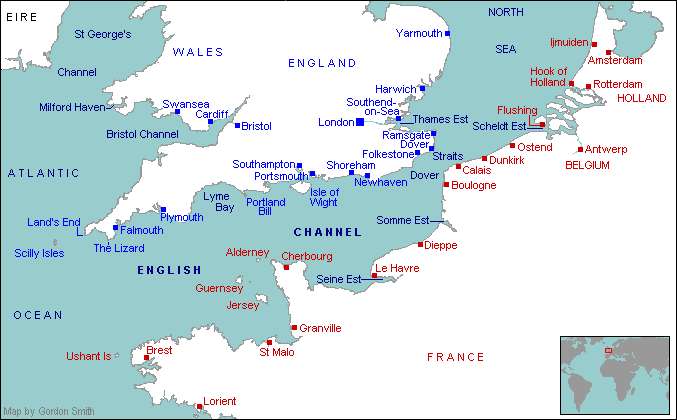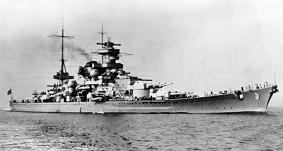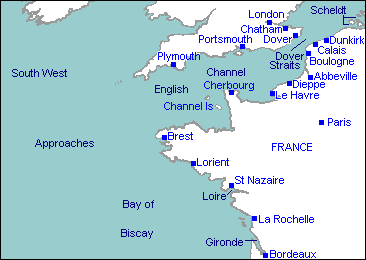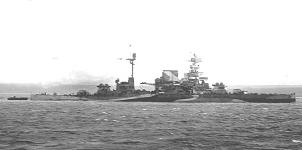End
of Dunkirk Evacuation, Britain's New Frontline

...1940
JUNE
1940
ATLANTIC
- JUNE 1940
German Raiders - Two
more set sail. “Thor” made for the South Atlantic
and returned to Germany eleven months later.
“Pinguin” left for the Indian Ocean around the
Cape of Good Hope, later operated in the Antarctic
and was finally lost in May 1941. Meanwhile
“Orion” which set out in April 1940 had laid mines
off New Zealand that accounted for gold-bullion
carrying liner “Niagara”.
6th - Three
armed merchant cruisers on Northern Patrol were
lost to U-boats in the waters between Ireland (R)
and Iceland (C) over the next nine days, starting
with “CARINTHIA” on the 6th/7th to “U-46”. 13th
- “SCOTSTOUN” was torpedoed three times by “U-25”
and sank north west of the Hebrides. 15th
- “ANDANIA” was sunk by German “U-A”, a Turkish
submarine building in Germany and taken over
Battle of the
Atlantic - The Allied loss of Norway
brought German warships and U-boats many hundreds
of miles closer to the Atlantic convoy routes and
in time within close range of the Russian convoys
that followed the June 1941 German invasion.
Britain's blockade line from the Orkneys to
southern Norway was outflanked and a new one had
to be established between the Shetlands and
Iceland. The Royal Navy started the massive task
of laying a mine barrage along this line. Within a
matter of days the first U-boats were sailing from
the Norwegian port of Bergen, while others were
sent to patrol as far south as the Canary and Cape
Verde Islands off northwest Africa. Italian
submarines joined them in this area, but without
any early successes. Towards the end of the month,
“U-122” and “U-102” were lost off the North
Channel separating Northern Ireland from Scotland,
possibly on mines according to German sources. It
was in this area and throughout the North Western
Approaches to the British Isles that such U-boat
commanders as Endras, Kretschmer, Prien and
Schepke enjoyed the ‘Happy Time' until early 1941.
U-boat strength was no greater than at the
beginning of the war, and there were never more
than 15 boats on patrol out of the 25 operational;
the rest were training or on trials. Yet from now
until the end of December 1940 they accounted for
most of the 315 ships of 1,659,000 tons lost in
the Atlantic. Many of these were stragglers,
independents or in unescorted convoys, yet it was
among the escorted convoys that U-boat tactics
were particularly threatening. Instead of
attacking submerged where they could be detected
by ASDIC, they were operating on the surface at
night as 18kt torpedo boats, faster than most of
the escorts. And there were few enough of these as
many were held back in British waters on
anti-invasion duties.
Monthly Loss Summary:
53 British, Allied and neutral ships of 297,000
tons from all causes, 3 armed merchant cruisers; 2
German U-boats, dates and causes of loss
uncertain.
EUROPE
- JUNE 1940
German Codes - 'Ultra'
was now breaking the Luftwaffe Enigma codes with
some regularity, and early in the month had its
first major breakthrough when supporting evidence
for the Knickebein navigation aid for bombers was
obtained. Army codes were more secure because of
the greater use of land lines for communications,
and the Naval ones were not penetrated until
mid-1941.
 4th-8th,
Norwegian Campaign, Conclusion ...... -
Following the capture of Narvik, Allied forces
totalling 25,000 men were evacuated in four days
from northern Norway, by which time King Haakon
VII and his Government were on their way to
Britain aboard heavy cruiser Devonshire.
8th - At the end of the evacuation, fleet
carrier
GLORIOUS
and escorting destroyers ACASTA
and ARDENT
sailed for Britain independently of the other
withdrawing forces. West of Lofoten Islands they
met the 11in gun battlecruisers “Scharnhorst” and
“Gneisenau” sailing to attack suspected Allied
shipping off Harstad. The British ships were soon
overwhelmed and sunk, but not before “Acasta” hit
“Scharnhorst” (right - MaritimeQuest) with
a torpedo. Few of the Royal Navy crews survived.
Allied submarines working with the Royal Navy
continued to play a part in operations off Norway
and have their share of losses. On the last day of
the campaign the Polish “ORZEL” on passage to her
patrol area and made famous after escaping from
invaded Poland, was presumed mined. Another Allied
boat was lost twelve days later.
4th-8th,
Norwegian Campaign, Conclusion ...... -
Following the capture of Narvik, Allied forces
totalling 25,000 men were evacuated in four days
from northern Norway, by which time King Haakon
VII and his Government were on their way to
Britain aboard heavy cruiser Devonshire.
8th - At the end of the evacuation, fleet
carrier
GLORIOUS
and escorting destroyers ACASTA
and ARDENT
sailed for Britain independently of the other
withdrawing forces. West of Lofoten Islands they
met the 11in gun battlecruisers “Scharnhorst” and
“Gneisenau” sailing to attack suspected Allied
shipping off Harstad. The British ships were soon
overwhelmed and sunk, but not before “Acasta” hit
“Scharnhorst” (right - MaritimeQuest) with
a torpedo. Few of the Royal Navy crews survived.
Allied submarines working with the Royal Navy
continued to play a part in operations off Norway
and have their share of losses. On the last day of
the campaign the Polish “ORZEL” on passage to her
patrol area and made famous after escaping from
invaded Poland, was presumed mined. Another Allied
boat was lost twelve days later.
9th-20th .....
Immediate Aftermath - The surviving
Norwegian troops surrendered to the German Army
and the Norwegian Campaign was over. Norway
and its people would not be liberated until after
the German surrender in May 1945. During that
time, many Norwegians escaped to fight with the
Allies, resistance movements grew in
effectiveness, and large German forces were
maintained there at Hitler’s command in case the
Allies should invade. Naval losses on both sides
during the campaign were heavy, and in the case of
the Germans included damage to battlecruiser
"Scharnhorst" (followed shortly by "Gneisenau")
and pocket battleship "Lutzow". 13th -
Five days after the sinking of “Glorious”,
aircraft from Ark
Royal attacked the damaged “Scharnhorst” in
Trondheim but to little effect. 20th -
Dutch submarine “O-13” also on passage to her
Norwegian patrol area was reportedly torpedoed in
error by Polish “Wilk”.
More recent
research suggests she was more likely sunk on the
13th June in a German minefield in
56º55'N-03º40'E. 20th - As the damaged
battlecruiser “Scharnhorst” headed for Germany,
“Gneisenau” feinted towards Iceland, but west of
Trondheim was torpedoed and damaged by British
submarine “Clyde”. Both battlecruisers were out of
action during the critical phases of the Battle
for Britain until the end of the year. German
Warships - By now, of the 23 surface ships
of destroyer size and above that took part in the
invasion of Norway, 17 had been sunk or damaged.
|
Main
Warship Sunk in Norwegian Campaign
|
| Warship
types |
Royal
Navy
|
Allied
Navies
|
German
Navy
|
| Carriers
|
1
|
-
|
-
|
| Cruisers
|
2
|
-
|
3
|
| Destroyers
|
7
|
2
|
10
|
| Totals
|
10
|
2
|
13
|
1st-4th, Dunkirk
Evacuation, Concluded (see
map above) -
As the evacuation continued under heavy ground
and air attack, destroyers KEITH,
BASILISK,
HAVANT
and the French “LE FOUDROYANT” were bombed by the
Luftwaffe and lost off the beaches, all on the
1st. 4th - The evacuation of the BEF and
some of the French troops trapped within the
Dunkirk perimeter came to an end. In the first
four days and nights of June, 64,000, 26,000,
27,000 and 26,000 men were saved to bring the
overall total to 340,000, including the bulk of
Britain's army in northern France. Naval and
civilian shipping losses were heavy. In destroyers
alone the Royal Navy lost six sunk and 19 badly
damaged, the French Navy seven sunk.

5th-30th,
Western Front, Concluded -
The Battle
for France began on the 5th with a German advance
south from the line River Somme to Sedan. 10th
- The evacuation of British and Allied forces
from the rest of France got underway. Starting
with Operation 'Cycle', 11,000 were lifted off
from the Channel port of Le Havre. 14th -
The German army entered Paris. 15th -
Operation 'Aerial' began with the evacuation of
Cherbourg and continued for the next 10 days,
moving south right down to the Franco-Spanish
border. 17th - The only major loss during
the evacuation from western France was off St
Nazaire. Liner “Lancastria” was bombed and sunk
with the death of nearly 3,000 men. 17th -
The French Government of Marshal Petain requested
armistice terms from Germany and Italy. 22nd
- FRANCE capitulated and the
Franco-German surrender document signed. Its
provisions included German occupation of the
Channel and Biscay coasts and demilitarisation of
the French fleet under Axis control. 25th
- The Allied evacuation of France ended with a
further 215,000 servicemen and civilians saved,
but Operations 'Aerial' and 'Cycle' never captured
the public's imagination like the 'miracle' of
Dunkirk. 25th - On the final day of the
evacuation, Canadian destroyer FRASER
was rammed and sunk by AA cruiser Calcutta
off the Gironde Estuary leading into Bordeaux. 30th
- The first German troops landed on the
Channel Islands, the only part of the British
Empire occupied by the Germans throughout the war.
Britain - By
early June 1940 the Royal Navy was taking steps to
meet the threat of German invasion. Any invasion
fleet would be attacked as it built up and before
it could reach British shores. Four destroyer
flotillas with cruiser support moved south, and
escort and other vessels were on patrol offshore.
The removal of these escorts from Atlantic convoy
duties contributed to the sinking of many merchant
ships, and eventually forced their return to these
duties. After setting out in early May, a heavily
escorted convoy carrying Australian and New
Zealand troops arrived in Britain.
Eastern Europe - Soviet
Russia occupied the Baltic states of Lithuania,
Estonia and Latvia. In July they
were formally incorporated into the USSR. Russia
also took over parts of Rumania.
Monthly Loss Summary:
77 British, Allied and neutral ships of 209,000
tons from all causes.
MEDITERRANEAN
- JUNE 1940
Italy Declares War -
Italy declared war on Britain and France on
the 10th. Two weeks later France was out of the
war. Still on the 10th, Australia, Canada, India,
New Zealand and South Africa declared war on
Italy.
France - Later
in the month Italian forces invaded southern
France but with little success. A Franco-Italian
Armistice was signed on the 24th, and included
provision for the demilitarisation of French naval
bases in the Mediterranean.
Malta - Italian
aircraft carried out the first of their many raids
on Malta on the 11th. Next day, the RAF made its
first attacks on Italian mainland targets.
 12th
-The Mediterranean Fleet with Warspite,
Malaya (right
- Maritime Quest), Eagle,
cruisers and destroyers sailed from Alexandria for
a sweep against Italian shipping in the Eastern
Mediterranean. South of Crete, light cruiser
CALYPSO
was torpedoed and sunk by Italian submarine
“Bagnolini”.
12th
-The Mediterranean Fleet with Warspite,
Malaya (right
- Maritime Quest), Eagle,
cruisers and destroyers sailed from Alexandria for
a sweep against Italian shipping in the Eastern
Mediterranean. South of Crete, light cruiser
CALYPSO
was torpedoed and sunk by Italian submarine
“Bagnolini”.
13th-
Mediterranean Fleet submarines operated out of
Alexandria on patrol off Italian bases and soon
lost three of their number (1-3). At the
time mines were usually blamed, but it turned out
Italian anti-submarine forces were far more
effective than expected. The first loss was
ODIN
(1) off the Italian coast in the Gulf of
Taranto, sunk by the guns and torpedoes of
destroyer “Strale”. 16th - The second was
GRAMPUS
(2), minelaying off Augusta, Sicily,
caught and sunk by large torpedo boats “Circe” and
“Clio”. 19th - Towards the other end of the
North African coast, ORPHEUS
(3) was sent to the bottom by Italian
destroyer “Turbine” north of the Cyrenaica port of
Tobruk, soon to become a household name .
15th - While
Royal Navy submarines suffered their losses, the
many Italian submarines on patrol suffered far
more heavily. Starting with the Red Sea and Indian
Ocean area, four {1-4} of the eight
submarines based there were soon accounted for
starting with “MACALLE” {1} which ran
aground, a total loss. 19th - At the
southern end of the Red Sea, “GALILEO GALILEI” {2}
on patrol off Aden was captured by armed trawler
“Moonstone” following a gun duel. 23rd -
Also in the Gulf of Aden, but off French
Somaliland, “EVANGELISTA TORICELLI” {3}
was sunk by destroyers “Kandahar” and “Kingston”
with sloop “Shoreham”. During the action,
destroyer KHARTOUM
suffered an internal explosion and sank in shallow
water off Perim Island, a total loss. 24th -
Off the Gulf of Oman, “GALVANI” {4} was
accounted for by sloop “Falmouth”.
17th - A further
six Italian submarines [1-6] were sunk
in the Mediterranean itself, half by the Royal
Navy. However the first to go, “PROVANA” [1]
was rammed and sunk off Oran, Algeria by French
sloop “La Curieuse” after attacking a French
convoy, and just a week before France was forced
out of the war. 20th
- “DIAMANTE” [2] was torpedoed by
submarine “Parthian” off Tobruk. 27th -
“LIUZZI” [3] was sunk by Med Fleet
destroyers “Dainty”, “Ilex”, “Decoy” and the
Australian “Voyager” south of Crete. 28th
- The first of two Italian submarines sunk by RAF
Sunderlands of No. 230 Sqdn was “ARGONAUTA” [4]
in the central Med as she was believed to be
returning from patrol off Tobruk. 29th -
The same Med Fleet destroyers after sinking
“Liuzzi” two days earlier, were now southwest of
Crete. They repeated their success by sinking
“UEBI SCEBELI” [5]. 29th - A
day after their first success, the Sunderlands of
No. 230 Sqdn sank “RUBINO” [6] in the
Ionian Sea as she returned from the Alexandria
area
23rd - Italian
submarine “Galvani” sank Indian patrol sloop
“PATHAN” in the Indian Ocean
28th - As the
Mediterranean Fleet 7th Cruiser Squadron covered
convoy movements in the Eastern Mediterranean,
three Italian destroyers carrying supplies between
Taranto in southern Italy and Tobruk were
intercepted. In a running gun battle, “ESPERO” was
sunk by Australian cruiser Sydney
to the southwest of Cape Matapan at the southern
tip of Greece.
British Force H -
By the end of the month, Force H has been
assembled at Gibraltar from units of the Home
Fleet. Vice-Adm Sir James Somerville flew his flag
in battlecruiser Hood
and commanded battleships Resolution
and Valiant,
carrier Ark
Royal and a few cruisers and destroyers. He
reported directly to the Admiralty and not to the
Commander, North Atlantic. From Gibraltar, Force H
could cover the Western Mediterranean and the
Atlantic, as happened in the May 1941 hunt for the
“Bismarck”. Units could also quickly transfer back
to the Home Fleet and UK waters as shortly became
necessary at the height of the German invasion
scare. There was no better example of the
flexibility of British naval power at this time.
Warship
Loss Summary - In
a confusing month, the Royal Navy had lost one
light cruiser, one destroyer, three submarines and
one sloop; the Italian Navy one destroyer and ten
submarines.
Merchant Shipping
War - Losses in the Mediterranean throughout
the war were generally low as most Allied shipping
to and from the Middle East was diverted around
the Cape of Good Hope.
Monthly Loss Summary:
6 British, Allied and neutral ships of 45,000
tons from all causes.